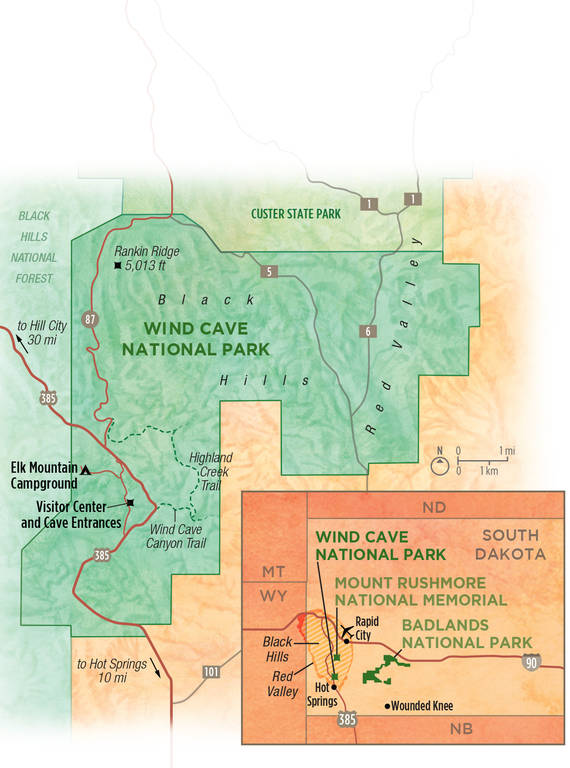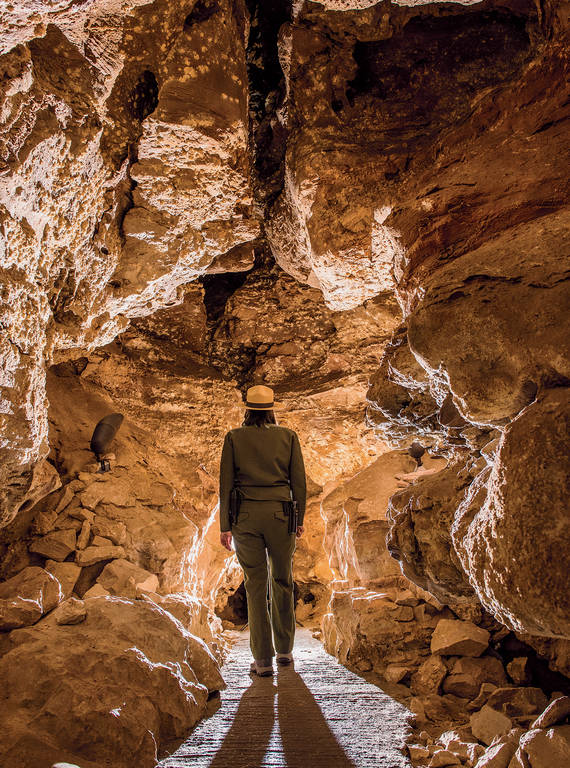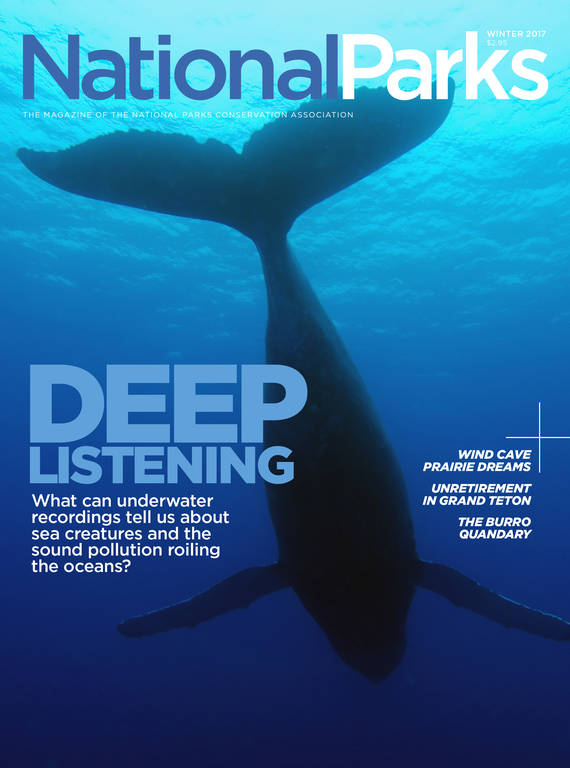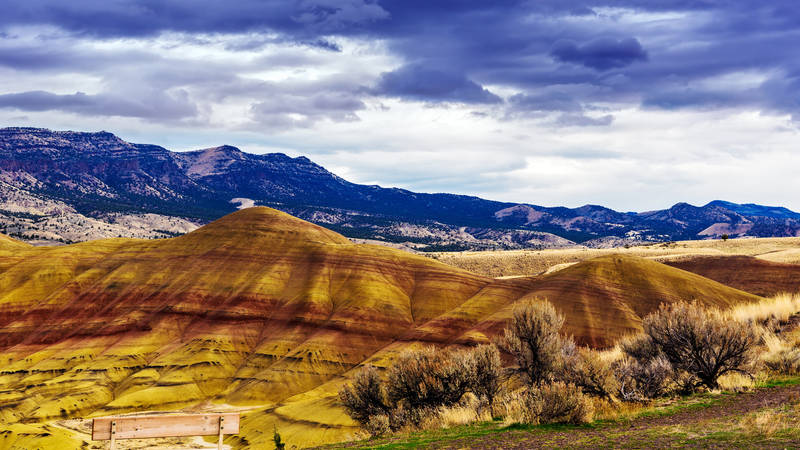Winter 2017
Prairie Portal
At Wind Cave National Park, the search for rare prairieland leads to an escape, a descent and a nighttime pursuit.
It was 1 a.m., and my eyes were sore from searching the inky prairie night. We were looking for one of the most endangered mammals in North America, the black-footed ferret. Which is nocturnal. And lives mostly underground. So: terrible odds.
I leaned out the window of a pickup truck, aiming a spotlight like a gun into the warm August air. Duane Weber, a National Park Service wildlife technician with the ruddy face and chipper attitude of someone who spends his days (and nights) outdoors, was doing the same, but also driving. We’d been illuminating the grassy roadsides of South Dakota’s Wind Cave National Park for two hours, searching for the telltale green eyeshine of a ferret, but nothing had turned up. Even Weber was starting to doubt we’d find one.

“These weasels have disappointed me many times,” he said, breaking into a grin nonetheless. “We’ve got only 30 or 40 black-footed ferrets in the park. A ferret may surface once every two or three days. And it might only be for a few minutes. Not only is this the proverbial needle in the haystack, but the needle keeps moving.” Weber erupted into laughter.
People who know about Wind Cave National Park — and not all that many do — usually come for one reason. It’s not the uncooperative ferrets, but rather the cave beneath the park’s surface. At 145 miles long, Wind Cave is the sixth-longest cave in the world and the most complex, meaning it has the most twists and turns. Two brothers chanced upon it in 1881 when, riding up a rocky ridge, they heard air whistling out of a hole — the wind of Wind Cave. But the cave had been discovered long before that. For many Lakota people, this place is sacred — it’s where their ancestors and bison emerged on Earth. They say the cave contains portals to other times, dimensions and places.
For years, I’ve been intrigued by this park, but unlike most visitors, I’ve been fascinated by what is on top of the cave. The 53-square-mile park is part of a landscape stretching from near-desert badlands terrain to the Black Hills, a mountainous expanse covered with dark ponderosa pines that give the range its namesake color. These mountains emerge like a jagged shadow from undulating prairie that extends for miles and miles. Here and there, rust-colored buttes dot the summer-green grass. And that grass — well, what a delicious place to live. It smells like straw and sage, is flecked with black-eyed Susans, and flits with grasshoppers and bees. Most of the species that evolved to live above Wind Cave still live there, making it one of the most intact prairie environments in North America.
The park was initially set aside in 1903 by President Theodore Roosevelt to preserve the cave. Then about eight years later, he and his peers at the American Bison Society targeted it as a reintroduction site for bison, which were by then nearly extinct. They shipped 14 of the animals (by rail, express) from the Bronx Zoo’s breeding program to the park. Elk, pronghorn antelope and black-footed ferret reintroductions followed. Today, the bison’s descendants here, a wild herd of around 500, are special: Unlike most other bison, they show no signs of cattle crossbreeding.
So, Wind Cave’s aboveground landscape is a portal in its own right: a way to slip back in time to see a rare mixed-grass prairie ecosystem. That’s why I came, even if I had to search all night to find its most elusive residents.
My first night in the park, however, Wind Cave’s animals came to me. I arrived at Elk Mountain Campground at dusk. The magazine photographer who was joining me, Craig Wolfrom, was due in at midnight, so I pitched my solo tent and retired early. As darkness fell, lightning and moonglow caught the twitching ears of a mule deer a few feet away. I fell asleep to the thrum of katydids, the yip of coyotes and the whoomp of nighthawks diving to assert their territory. And then something — some large thing, seemingly just outside the thin wall of nylon — grunted at me from a primal place in its body. I sneaked a look outside, but nothing was there. Later, I asked the campground manager: Were those bison? Yes indeed. The bass soundwaves from the males’ breeding calls can travel from a mile away. The mountain lions, he said, were out there, too — but silent.
The next day, I started to explore in earnest. Wind Cave has 30 miles of trails, and biking is permitted on some 30 miles of paved and unpaved roads, but most people who travel here don’t hike or bike. They check out the cave, take a quick drive, then leave. Craig and I did the opposite: We investigated the landscape in his Suburban with two rental bikes inside and saved the cave for later. I especially wanted to see the park’s less-developed eastern side, an area called the Red Valley. It has two backcountry roads and acres of grassy hills where the bison tend to hang out. It’s also where 5,556 acres of recently purchased land will soon be open to visitors.
We looked for the buffalo jump, a cliff that native people used to hunt bison as early as 4,000 years ago, but for now, the newly added land is blocked off by “no-entry” signs. Unable to see much, we parked nearby and biked the swells of a gravel road as the bulls groaned and a thundercloud brewed in shades of indigo.
But biking gave us only a taste. I wanted to be enveloped by this ecosystem. So the following day, we hiked Wind Cave Canyon Trail, an old dirt road flanked with pines near the visitor center. We started, then stopped short: A male bison stood squarely on the path, staring at us. They’re reputedly peevish. I remembered what the young staffer at the visitor center cheerfully told me: “We haven’t had any gorings yet this year!” Not wanting to be remembered as the first goring of 2016, we diverted, skirting the bison by hiking on the ridge above.
We picked up the trail after he disappeared, passing by short, pretty canyon walls, notable for the same ruddy sandstone that we’d seen in the Red Valley. I learned later that this crumbly sedimentary layer, called the Spearfish Formation, is a signature rock of the Black Hills. When the canyons gave way to grass, we turned left to hike up the Highland Creek Trail, which put us on a wide prairie plateau. Here, the path faded to a suggestion in the swish of little bluestem and blue grama grass. We saw no other hikers at all. Just the curving earth, the prairie dogs and us. We felt exultant. Until the bison.

Interpretive ranger Sina Bear Eagle leads a tour through Wind Cave.
© CRAIG WOLFROMAs we rounded a hill, he surprised us again, his dark, humped mass planted only 15 yards away in an outcrop of the Spearfish Formation. Again he watched us, his gaze inscrutable; his tail began to arch. I recalled that a raised bison tail signals a warning. Or was he just leaving a buffalo chip?
A throb of anxiety rose in my chest. I looked over at Craig, but he was placidly changing lenses. His calm, paradoxically, made it worse. No ally, no cover. “I feel nervous,” I announced to Craig and the bison, as if “I feel” statements could argue this half-ton bully away. I circled the animal with a wide berth, and Craig followed. We descended a hill and finally saw it swaying away from us. Then we ran, not only to ensure our escape but because we realized we were nearly late. An interpretive ranger named Sina Bear Eagle was meeting us for a cave tour.
Travel Essentials
Bear Eagle, who was wearing a wide ranger hat over her straight layered hair, explained the place with dramatic flair, in which she clearly delights. (The park staff I met all seemed to love Wind Cave National Park; their devotion is infectious.) She brought us to the cave’s “natural entrance,” the hole in gray rock that the brothers had stumbled across in 1881. I was shocked by how small it was. If you could somehow fit through a coat hanger, you could fit through this hole.
“This is where the Lakota people emerged from the spirit world,” Bear Eagle told us. “It is such a sacred site, very supernaturally powerful. Because of the portals, Lakota people who come into the cave often take protection with them, such as sage.”
When the outside air pressure is low, Bear Eagle explained, the cave exhales a stream of air that’s 54 degrees Fahrenheit. “And on a high-pressure day, it inhales — it sucks in wind. We call it Maka Oniye,” she said, using the Lakota words. “Breathing earth.” She explained that scientists have measured the barometric airflow emerging from the opening and estimate that the 145 miles of known passages comprise only about 10 percent of the cave.
This cave is why Bear Eagle joined the National Park Service. She first came to this spot when she was about 11 years old. For Lakota people, hair connects to the soul, so she dropped some strands in the dirt to be sure she would someday return. Eventually, she studied graphic design and lived in England but then found herself lost about the next step. While taking some cultural studies classes at Oglala Lakota College on the nearby Pine Ridge Reservation, she saw on Facebook that Wind Cave was hiring. Now 30, she is the park’s only Lakota employee. She finds the work intensely gratifying, though it can be difficult, too. “Sometimes it seems that visitors aren’t respecting the cave in the way that they should,” Bear Eagle told me. “And for many local people, there are still hard feelings about how the Black Hills changed hands.”
Visiting Wounded Knee
The Black Hills and surrounding areas once belonged to the Lakota, Cheyenne and Arapaho people. The 1868 Fort Laramie treaty protected the Black Hills for the Lakota, but in 1877, an act of Congress illegally seized their land, and the dispute has never been fully resolved. “Instead of being really upset, I’ve come here to make sure Lakota viewpoints are asserted,” Bear Eagle said. “I teach the history. I’m doing what I can to make a change.”
Bear Eagle guided Craig and me through a doorway that has been blasted into the rock, leading us on a version of the Natural Entrance Tour that visitors can take for $12. I was amazed. Arches of sepia, tan and honey-toned rock curved above us. The air was dry, cool and still. The floor was concrete, and carefully placed lights cast a soothing glow. Dark areas twinkled with crystals when Bear Eagle shined her flashlight. Overhead, a rare calcite formation called boxwork looked like spiderwebs, neurons or fiberglass insulation, sealing us off from the world above.
Bear Eagle ended our tour in a wide cavern called the Fairgrounds. “This,” she paused suspensefully, “is the 1890s version.” She cut the lights, as if a candle lantern had burnt out. Total darkness blanketed us. Bear Eagle asked us to remain quiet for 15 seconds. Apparently, visitors have a difficult time when she does this on a regular tour. People always shuffle or clear their throats. I heard nothing but the pulse of blood in my ears. I felt suspended, dimensionless, awed; it was a sensation unlike anything I’d experienced above ground. Then Bear Eagle flipped the switch back on and led us out.
Although Wind Cave’s prairie and cave were even more dazzling than I’d imagined, the real prize I was hoping for was seeing a black-footed ferret. I write often about wildlife and have a special affection for weasels of all kinds — from ermines to mink to wolverines. Maybe it’s the combination of their beauty and personality: vicious in a lustrous coat. Black-footed ferrets, Mustela nigripes, are the ultimate — the rarest weasel around.
These animals are about the size of a foot-long sub plus a tail; their coats are cream-colored with black markings. They mostly eat prairie dogs, diving into burrows at night to snatch them by the neck. Ranchers believe prairie dogs compete with cattle for grazing, so they have tried to exterminate them, nearly killing off black-footed ferrets in the process. M. nigripes was listed as endangered and a breeding program was established, but even today only around 300 wild ones exist in the Great Plains. Biologists have released captive-bred and wild ferrets in Wind Cave National Park three times, and the resulting population is hanging on.
The park’s biology team helps sustain the ferrets. They regularly dust thousands of prairie dog burrows with flea treatment to keep insect-borne sylvatic plague at bay. And every fall, they spend six nights capturing and releasing ferret families to count and examine them. During my visit, the team invited Craig and me to assist with a preliminary survey of the prairie dog colonies, called “dogtowns,” which would help with upcoming ferret-monitoring efforts.
As we aimed our lights along the dark roads, the wildlife of Wind Cave watched. In the hairpin turns by the ponderosa pines, glimmering elk eyes reflected back. Once on the prairie, we felt surrounded: The bright red eyes of a night bird called a poorwill winked at us, and we spotted olive coyote eyes and shiny pronghorn eyes. This was invigorating for a while, but as the night wore on, our hopes of seeing a ferret were drooping. At 1:15 a.m., we decided to head back to the visitor center.
Suddenly, passing through the last stretch of dogtowns, Weber murmured: “Uh oh, uh oh, uh oh….” What? Instinctively, we both started whispering. “Ferret,” he said. “That’s a ferret.”

National Parks
You can read this and other stories about history, nature, culture, art, conservation, travel, science and more in National Parks magazine. Your tax-deductible membership donation of $25 or more entitles…
See more ›Weber tossed me the binoculars, exited the cab and trained his lamp about 20 yards ahead of us. “Darn,” he said. “I’ve got a bum battery.” I fumbled with the binoculars’ focus. In the fading circle of light, two spots of emerald gleamed at me, narrowly spaced and low on a burrow. We walked up to the eyes, my shadow growing long and elastic. The ferret ducked down, then back up. “They’re intensely curious,” whispered Weber. “He’s playing jack-in-the-box.”
Weber returned to the truck to replace his light, leaving me alone with the bobbing mammal. I did not move and barely breathed; I just focused on it, grinning. Minutes later, Weber returned. We peeked in the burrow, but the ferret was back in for good.
It wasn’t until the next morning, after sleeping in until 9 a.m., that I realized what my search at this park was about. It wasn’t just for the ecological adventure or the thrill of finding something scarce. It was for the reassurance. I couldn’t make out the ferret’s body well, but its gaze alone was comforting: These creatures are surviving. This rare thing is still there. A patch of North American prairie and all it contains is still, more or less, out there.
About the author
-
 Laura Allen Author
Laura Allen AuthorLaura Allen is a writer and a museum professional. Her work has taken her to Alaska, the Everglades and beyond. She is based in New York.



